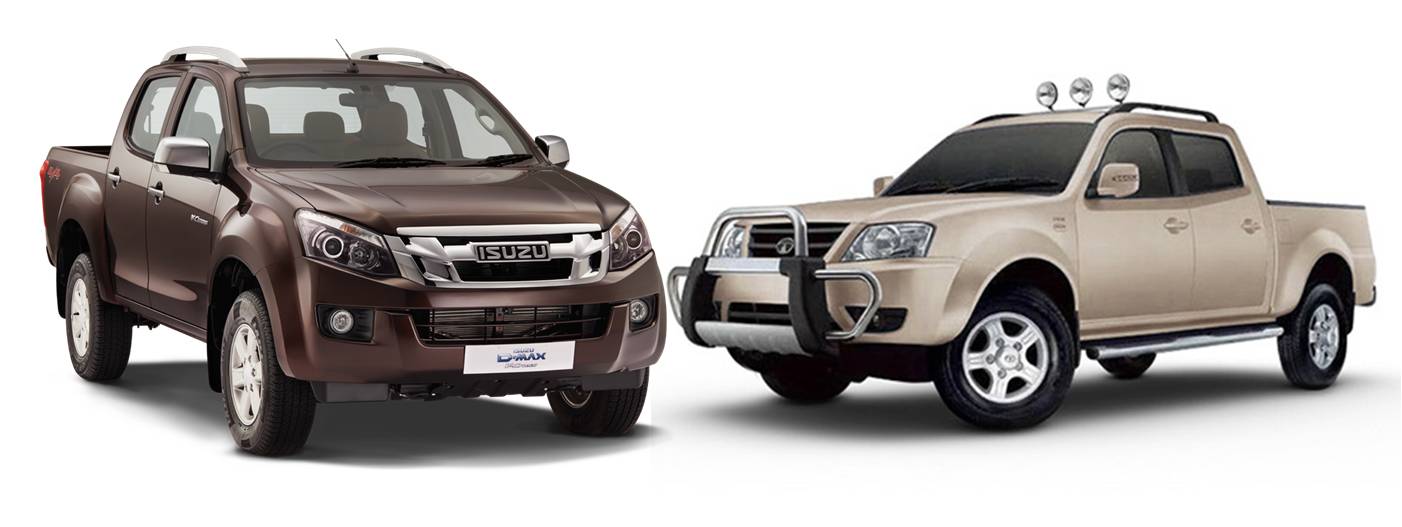Pickup vehicles have a high significance in majority of the commercial sectors, including the local cargo companies. The amalgamation of a passenger vehicle with an open goods carriage forms a smart hybrid.
To offer the market with such useful vehicle, Isuzu came up with the first generation of Isuzu D-Max, a 5-seater, four door pickup mini truck that was an immediate hit on a global scale. The second generation of this pickup car was launched in 2012 and debuted in Asia in 2013. In this second generation D-Max, Isuzu retained its iTEQ engine, with a slight tuned up power. It was then that the 4WD variant was named as the D-Max V-Cross for better off road capabilities.
On the contrary, the Tata Xenon was first launched as a remodeled form of Tata TL in 2007. However, the cross terrain variant (Xenon XT) was introduced in 2009 and was an immediate hit in the European market.
At any given day, both the pickup mini vans could get you into a dilemma of choosing the better one among them. On paper, both the vehicles are driven by similar drivetrain, are built on same dimensions and fulfill their needs in ways more than one. But how could a prospect simply choose one among the two? How would you determine which one of the two fits the bill well enough? If you are looking for the answer of the above questions, read on.
Exterior and Styling
The V-Cross variant of the Isuzu D-Max has a higher ground clearance, wider track and longer wheelbase, just perfect for both on and off road driving. The ORVMs gets chrome finish with turn indicators installed. Adding to the rugged and tough look are the rooftop rails, single slatted radiator grille and sharply designed headlamps. In terms of safety, the V-Cross gets dual front airbags for the driver and front passenger along with ABS and EBD braking system.
Coming back to the Tata Xenon XT, the pickup mini truck does feature a stylish exterior body. The front bumper is body colored and features clear lens fog lamps. The vehicle has a large front windscreen and a highly spacious cabin. Apart from the stylish exteriors, the car also packs a good number of safety features like child seat port, a driver seatbelt warning, an open door indicator and ABS and EBD.
Engine power and Transmission
The Isuzu D-Max V-Cross is driven by a powerful 2499cc turbocharged four cylinder engine which generates a highest power of 134 bhp at 3,600 revolutions per minute and a peak torque 320 Nm at 1,800-2,800 revolutions per minute. This power is transmitted to all the four wheels through a manual transmission gearbox, thus indicating its monstrous ability as an off-road pickup.
The Tata Xenon XT does not appear to be any less than its counterpart, holding a 2.2-litre diesel engine that offer 2,179cc displacement. The engine can produce up to 140 bhp of power at 4,000 revolutions per minute and a maximum torque of 320 Nm at 1,700-1,800 revolutions per minute. The power is transmitted to rear wheels, but you can opt to go for a 4-wheel drive variant. The engine is mated with a 5-speed manual transmission and can hit a top speed of 160 kilometers per hour.
Face off
Having piled up heaps of tangible comparisons between the Isuzu D-Max V-Cross and the Tata Xenon XT, there are many other factors that need to be drawn while on a quest to choose the best one among them. Even though the drawbacks for both these pickup vans are limited, over the years, they have piled up several reviews for themselves, some positive and some negatives. While the Isuzu D-Max presents better off road capabilities and drivetrain, and a spacious interiors, the inclination towards them is highly affected by the average service network. Moreover, at a price tag of around Rs. 13.5 lakhs to Rs. 14 lakhs, the D-Max costs a good Rs. 2.5 lakhs more than its counterpart, which sells at an exclusive showroom price of Rs. 11 lakhs to Rs. 11.5 lakhs. Hence, the distinction calls for a diligent precision.
On the other hand, the Tata Xenon XT comes with a lower displacement but does produce more power comparatively. However, on highways and while on high speed, the engine tends to produce a lot of noise. The fuel economy too turns out to be a matter of concern.
Conclusion
With both the mini pickup vans are in business for a fairly long period of time, it would be absolutely wrong to say that the one could cleanly overshadow the other hands down. However, if we look closely, there would be several points creeping up that will thrive for dominance over the other. But yet, each of them works on their specialized field. With a sturdy and attractive build, the Tata Xenon XT suits the urban road conditions, while the Isuzu D-Max, with all its power, better off-road drivetrain and better safety features, turns out to be the best in rural sectors with uneven road conditions.

